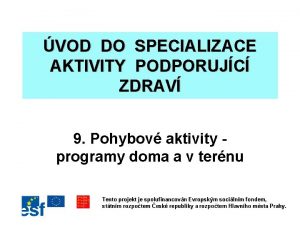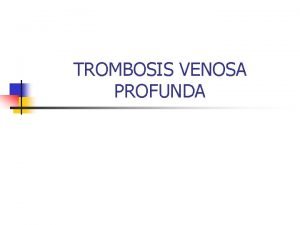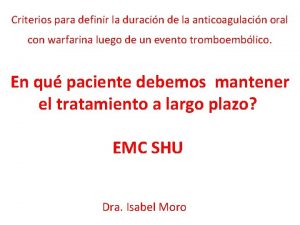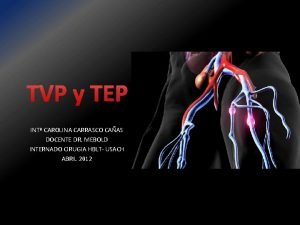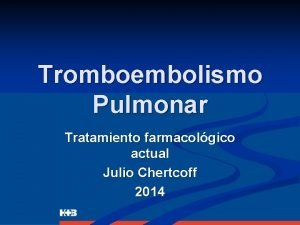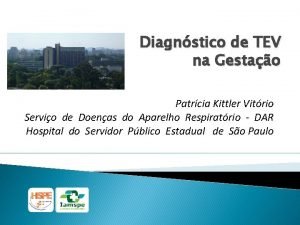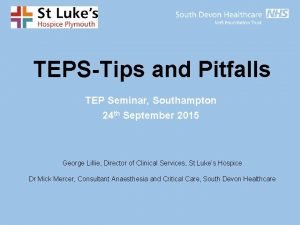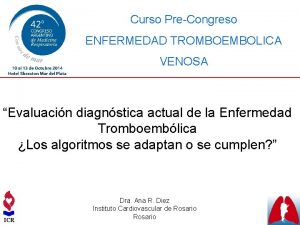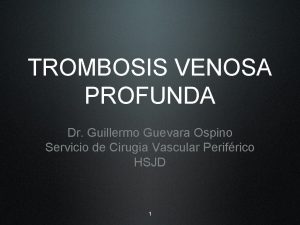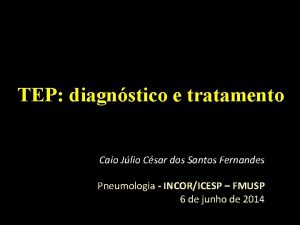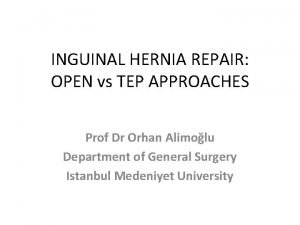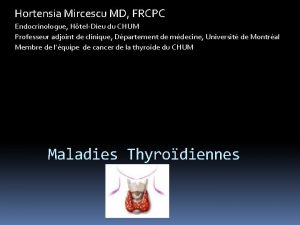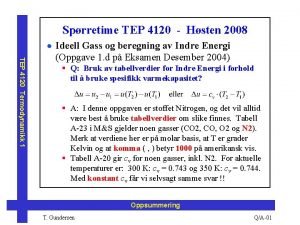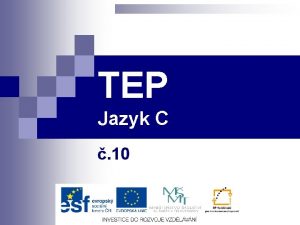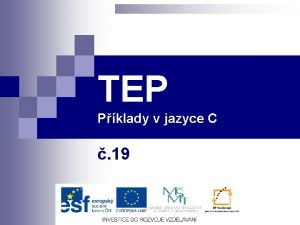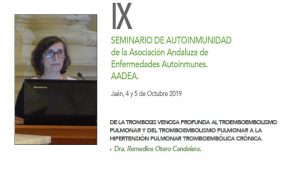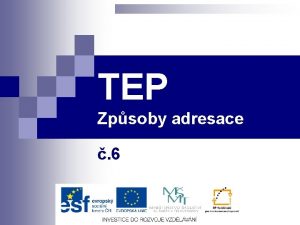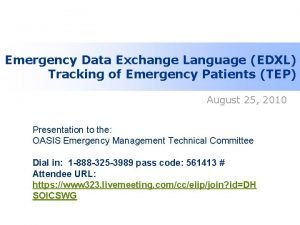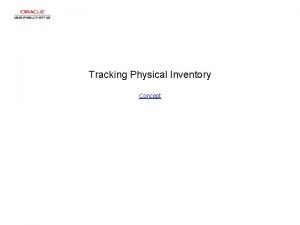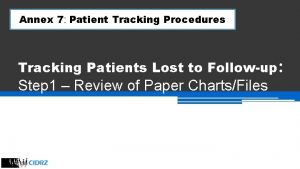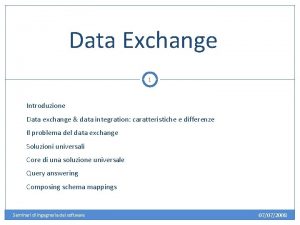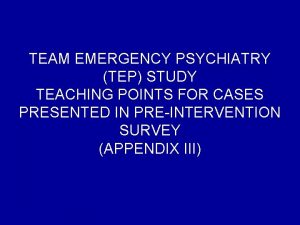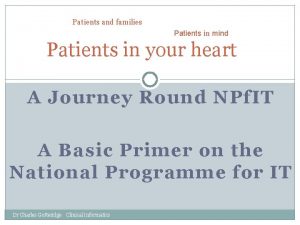Tracking of Emergency Patients TEP Emergency Data Exchange






















- Slides: 22

Tracking of Emergency Patients (TEP) Emergency Data Exchange Language (EDXL) Messaging Standards Development © 2009 Evolution Technologies Inc, All Rights Reserved.

Agenda § Welcome & Acknowledgements § Program Background & Process § TEP Overview § TEP Status and Next Steps § Questions 7/15/2009 EDXL-Tracking of Emergency Patients (TEP) 2

The Program Managed by the U. S. Department of Homeland Security’s (DHS) Science and Technology Directorate, CID delivers on its mission through five thrust areas. CID Division Cyber Security Reconnaissance, Surveillance, and Investigative Technologies Communication, Interoperability and Compatibility Knowledge Management Tools Basic/Futures Research Office for Interoperability and Compatibility Mission: Through a practitioner-driven approach, CID creates and deploys information resources— standards, frameworks, tools, and technologies—to enable seamless secure interactions among local, state and homeland security stakeholders. 7/15/2009 EDXL-Tracking of Emergency Patients (TEP) 3

EDXL Standards Background § Following voice interoperability programs such as SAFECOM, the OIC’s interoperable messaging standards program was initiated as one of the President’s e-Gov initiatives in 2001. § Its mission is to serve as the standards program within the Federal Government to facilitate local, tribal, state, and federal public safety and emergency response agencies to improve emergency / disaster response through effective and efficient interoperable data sharing. § The EDXL program (Emergency Data Exchange Language) is a practitioner-driven, public-private partnership that creates information sharing capabilities between disparate software applications and systems that support emergencies and disasters – “Outside of Hospital Process” 7/15/2009 EDXL-Tracking of Emergency Patients (TEP) 4

EDXL Standards Background § EDXL will accomplish this mission through the standardization of specific messages (XML messaging interfaces) to facilitate emergency communication and coordination - particularly when more than one profession or jurisdiction is involved. § This open and public process is driven solely by crossprofession emergency & disaster support practitioners through an OIC-sponsored Practitioner Steering Group (PSG) and Standards Working Group (SWG). § This program works with the EIC (Emergency Interoperability Consortium), Vendor communities, and OASIS (Organization for the Advancement of Structured Information Standards). 7/15/2009 EDXL-Tracking of Emergency Patients (TEP) 5

Standards Development Process 7/15/2009 EDXL-Tracking of Emergency Patients (TEP) 6

OASIS EDXL Standards Common Alerting Protocol (CAP 1. 1) § The original “model” for this standards process, prior to “EDXL” nomenclature. Exchange emergency alerts, notifications, and public warnings § Widely implemented (DHS S&T CBRN, DNDO, NOAA Haz. Collect, USGS, Global Tsunami Alerting System, IPAWS, ITU, EAS mandate and Over 100 commercial vendors with known EDXL implementations) Distribution Element (DE 1. 0) §Secure, flexible routing of any type of content (XML and non-XML) §Public and Emergency response / management focus. Messages may be routed by specific recipients, by a geographic area, or by other flexible codes such as agency type (police, fire, etc. ). 7/15/2009 EDXL-Tracking of Emergency Patients (TEP) 7

OASIS Approved Standards Resource Messaging (RM 1. 0) § RM was adopted as an OASIS standard in November 2008. § Provides a suite of 16 standard XML messages for data sharing among emergency and other information systems that deal in requesting and providing emergency equipment, supplies, people, and teams such as a Request for Resources and Response to Request for Resources for incident preparedness, response and recovery. Hospital AVailability Exchange (HAVE 1. 0) § HAVE was adopted as an OASIS standard in November 2008. § HAVE provides an XML message for communication of the status of a hospital, its services, and resources, including bed capacity and availability, emergency department status, and available service coverage. This assists hospital coordination and routing of patients to facilities for care during emergencies 7/15/2009 EDXL-Tracking of Emergency Patients (TEP) 8

EDXL In-Process Standards Situation Reporting (Sit. Rep) § Sit. Rep was submitted from the practitioner process to OASIS at the end of March 2009 § The OASIS Messaging & Notifications subcommittee hold weekly sessions to develop the standard. § Sit. Reps support more effective preparation, response, management and recovery through exchange of information about a situation, incident or event, providing a basis for incident management decision making over its life -cycle, and the operational picture of current and required response in an actionable form. 7/15/2009 EDXL-Tracking of Emergency Patients (TEP) 9

EDXL Tracking of Emergency Patients (TEP) üPractitioner-driven Process; DHS-Sponsored üPart of the EDXL Process / Family of Standards 7/15/2009 EDXL-Tracking of Emergency Patients (TEP) 10

Background § The NASEMSO with many other agencies and organizations recognized the need for standards-based interoperability to realize the potential of the numerous patient tracking systems in existence or planned § Introduced TEP to the DHS S&T Office for Interoperability and Compatibility (OIC) – sponsor of the EDXL development process § This mature process has a proven track-record for developing cross-profession, practitioner-driven messaging standards § Effort was Initiated by the PSG as the next EDXL Priority § Help close HITSP ER-EHR IS 04 Gaps § Supports HHS & DOD AHRQ Objectives 7/15/2009 EDXL-Tracking of Emergency Patients (TEP) 11

Tracking of Emergency Patients (TEP) Research • OASIS EDXL • ASTM Continuity of Care Record (CCR) • HITSP ER-EHR • HL 7 Continuity of Care Document (CCD) • PHIN Standards • Vehicular Emergency Data Set (VEDS) • National EMS Information System (NEMSIS) • Data Elements for Emergency Department Systems (DEEDS) • COMCARE/HIMSS Integrated Emergency Medical Response Initiative (IEMRI) • COMCARE Integrated Patient Tracking Initiative (IPTI) • Coordinated Assistance Network (CAN) • PRE-HOSPITAL • IN HOSPITAL 7/15/2009 HHS AHRQ Evacuee Movement HHS AHRQ Patient Tracking Locator (PTL) DHS - NIMS Asst. Sec. for Preparedness & Response (ASPR) Do. D & Other Systems. E. g. TRAC 2 ES NDMS AHLTA Mobile (aka BMIST) JPTA Tac. Med. CS FCC JAC Web. Medis MCI-PT Detailed Requirements TN DOH Boston PTS for Public Health Christiana Care Health System HERDS - NYS National Capital Region San Francisco, STARRS EDXL-Tracking of Emergency Patients (TEP) 12

TEP Development Process 7/15/2009 EDXL-Tracking of Emergency Patients (TEP) 13

TEP Steering Committee Week to Week Project Engagement LN FN EMAIL PHONE Organization Represented Mann Clay, Dr. clay. mann@hsc. utah. edu 801 -581 -6410 NASEMSD, National EMS Information System (NEMSIS) Mears Greg, Dr. gdm@med. unc. edu 919 -843 -0201 UNC Chapel Hill EMS Medical Director Donohue John jdonohue@miemss. org 410 -207 -0071 Maryland Institute for EMS Systems (MIEMSS) Sexton Jeff jeff. sexton@state. tn. us 615 -253 -8301 Tennessee DOH Office of Information Technology Services, HITSP Moreland Joe joe. moreland@ems. ks. gov 785 -296 -7412 Kansas Board of EMS Whitney Jolene jrwhitney@utah. gov 801 -273 -6665 Bureau of EMS State of Utah Mc. Ginnis Kevin mcginnis@nasemso. org JNEMSLC, NASEMSO, Vice-Chair-OIC PSG, National 207 -512 -0975 Association of State EMS Officials-NASEMSO 7/15/2009 EDXL-Tracking of Emergency Patients (TEP) 14

Tracking of Emergency Patients Purpose & Objectives § All Hazards – Mass Casualty Focus but Support Local, Day to Day Incidents § XML Standards-based Information-sharing (messaging) Between Disparate Systems that Track Patients - at Local, State and Federal Levels. § Facilitate More Effective Emergency Medical Management, Patient Tracking, and Continued Patient Care Capabilities (post-EMS) § Facilitate Effective Use of Assets – Getting Patient to the Right Facility § Facilitate Early Preparation of Receiving Facilities (ED / Hospital) § Assist in the “Finding” of Patients During and After an Emergency (families etc. ) § Help Close Gaps - HITSP (Health IT Standards Panel) ER-HER, IS 04 § Support HHS & DOD AHRQ standards-based information sharing requirements Ø Re-use existing standards and efforts – avoid duplication of effort Ø Provide input to data standardization activities 7/15/2009 EDXL-Tracking of Emergency Patients (TEP) 15

Recent Developments Eat the Elephant in 1 bite or 2? § Acknowledge the broader context, but phased approach § Triage / separate “victims” into “Patients” and “non-Patients” § Agreed to address broad scope within 2 Phases: § Phase I – Tracking of Emergency Patients § EMS / Patient Centric – EMS life-cycle processes § Phase II – Extend to Track General Population “victims” § Non-Patient (“Healthy”) population § Evacuees, Displaced, Regulation, Family Re-unification § OASIS may combine Phase II requirements into the Phase I TEP standard, create a new standard, or use Phase II requirements to create a new version as appropriate based on requirements and timing. Victim: Generic term for a person displaced, evacuated, expired and/or requiring medical attention Patient: A victim requiring medical attention or being medically evaluated; or a fatality 7/15/2009 EDXL-Tracking of Emergency Patients (TEP) 16

TEP Phase I Process & Info Supported § Re-use Responder Dispatch Information when Available § Focus Tracking Process from EMS-certified Patient Encounter Through Release, Hospital Admission or Morgue § Supports Hospital Evacuations & Patient Transfers (where EMS-certified resources are involved) § Share Patient Movement/Tracking, Disposition, and some Condition and Care Information During Emergency Medical Transport § TEP Information-Sharing Supports: § Basic Incident Occurrence Information (9 -1 -1, Dispatch) § Care Provider Demographics (e. g. Search & Rescue, EMS) § Unique Identification of the Patient § Tracking of Physical Movement and Transition Between Care Providers § Basic Patient Emergency Evaluation, Symptoms and Care § Patient Outcome and Disposition After Release from Emergency Care 7/15/2009 EDXL-Tracking of Emergency Patients (TEP) 17

TEP Phase I Scope 7/15/2009 EDXL-Tracking of Emergency Patients (TEP) 18

Information-Sharing Opportunities § Dispatch / CAD Initiating Information § Patient Tracking Systems at Local, State and Federal Levels § Emergency Department / Hospital § Cross-Profession, e. g. § EMS § Emergency Management § Various Health Organizations and Care Facilities § AHRQ National Database 7/15/2009 EDXL-Tracking of Emergency Patients (TEP) 19

Target Project Time-Line Deliverables-Milestones Tentative Delivery Dates Messaging Standard Research Report – Research Artifacts January – COMPLETE Initial identification of Stakeholder Group Mid-February – COMPLETE Project Initiation Document (PID) Outline Mid-February – COMPLETE Draft Project Initiation Document (PID) April – COMPLETE HHS Summit - Face to Face meetings (TEP Steering Committee) Revised PID & Stakeholder/SWG kick-off April 4 -8 - COMPLETE May - COMPLETE Comment Responses & PID Refinement. Vendor input. Scenarios & Use Cases. Requirements & draft Messaging Specification Design & Development Stakeholder/SWG/PSG draft specification review. Mapping and Gap Analysis – existing standards June - August September Concurrent with Document Life Cycle Issues addressed & revised document. Stakeholder/SWG/PSG review & approval Submit Package to EIC / OASIS TC 7/15/2009 EDXL-Tracking of Emergency Patients (TEP) October / November 20

Immediate Next Steps § Responses to the 157 TEP-PID comments received § Revise the PID document to reflect this approach and applicable comments § Re-distribute the revised PID, also including vendor contacts identified by the stakeholder groups. § Continue detailed analysis leading to a TEP Requirements and draft Messaging Specification, for submission to OASIS. § Plan Input-loop & continuity during SDO Process § Advocacy for the Resulting Standard(s) 7/15/2009 EDXL-Tracking of Emergency Patients (TEP) 21

Contact Information Kevin Mc. Ginnis, Practitioner Lead mcginnis@nasemso. org Denis Gusty, DHS Lead Denis. Gusty@dhs. gov Tim Grapes, Staff Lead tgrapes@evotecinc. com Questions? 7/15/2009 EDXL-Tracking of Emergency Patients (TEP) © 2009 Evolution Technologies Inc, All Rights Reserved. 22
 Maximální srdeční tep
Maximální srdeční tep Maximální srdeční tep
Maximální srdeční tep Tratamiento para tromboembolismo pulmonar
Tratamiento para tromboembolismo pulmonar Site:slidetodoc.com
Site:slidetodoc.com Rx de tep
Rx de tep Cv tep
Cv tep Warfafina
Warfafina Signo de empastamiento gemelar
Signo de empastamiento gemelar Contraindicaciones fibrinolisis tep
Contraindicaciones fibrinolisis tep Sherlock transitions
Sherlock transitions Patricia kittler vitorio
Patricia kittler vitorio Tep form devon
Tep form devon Tep trees
Tep trees Uhcl tep
Uhcl tep Score de wells simplificado
Score de wells simplificado Usa csc tep co
Usa csc tep co Signo de olow
Signo de olow Tep
Tep Cintilografia
Cintilografia Myopectineal orifice boundaries
Myopectineal orifice boundaries Hyperthyroïdie grossesse
Hyperthyroïdie grossesse Tao tep
Tao tep Tic tac tep
Tic tac tep

